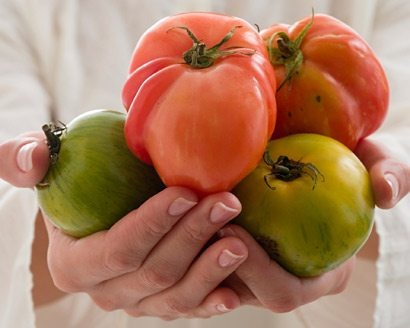Everything You Need To Know About Tomatoes
It's the most wonderful time of the year — the time when all we can think about are Caprese salads and tomato pies; when our gardens are overflowing with ripe, juicy, orbital presents; and when a simple tomato, mayo, and salt sandwich is the best thing we've ever eaten. It's tomato season, so it's time to learn everything you need to know about tomatoes.
Click Here to See 9 New Tomato Recipes
What They Are
Believe it or not, a tomato is a fruit, although some people most commonly think of it as a vegetable because of its savory qualities. Dating back to the 16th century, tomatoes come in all shapes, sizes, and colors, including cherry, plum, beefsteak, pear, red, green, and yellow. Their versatility, flavor, and ease of growth make them one of the greatest contributions to world cultivation.
When to Pick 'Em
While generally all of summer is considered tomato season, the end of summer is the best time of the year to pick tomatoes because it's when they've been growing on the vine the longest. Most tomatoes that you find in supermarkets have been picked prior to being ripened so that they don't perish in the store, but you can be certain that the tomatoes you find in August have been vine-ripened to their fullest. When buying tomatoes, you should look for plump, glossy, and heavy tomatoes without bruises or cracks. Smelling the vine of the tomato is another way to check for ripeness; it should have a garden-y, earthy aroma.
Storing for Glory
If you're buying a plump, ripened tomato in August, the best thing to do is to use it right away, but if you're not, make sure to keep it in a cool spot in your kitchen out of the sunlight. One of the most common mistakes with storing tomatoes is putting them in the fridge, which will cause them to lose their acidity and flavor.
Many people don't think of freezing tomatoes, but this can make them last for up to a year. Lay whole tomatoes across a baking sheet and freeze, and then add to a Ziploc bag for storage. The skins will crack while they're freezing, but this will only make it easier to peel once you're ready to use them.
Another way of storing tomatoes is to dry them out, which can be done using an electric dehydrator or a by baking slices of tomatoes at a low temperature like 100 degrees for 10 to 15 hours. This will allow you to keep tomatoes to use to flavor sauces and soups later on in the year.
Peeling, Seeding, and Slicing Tomatoes
To peel a tomato, cut an X at the bottom and drop it in boiling water for 10 to 45 seconds (the riper the tomato the less time it will take). When the flaps of the X start to fold back and look tender, remove the tomato from the boiling water and place it in an ice bath to cool. Peel the skins starting from the X and pulling back to the top. The easiest way to seed a tomato is to use a spoon to scoop out the flesh. If you're not making a sauce or stew, where seeds would be an eyesore, it's recommended to keep the seeds because they add flavor to the dish. Always use a serrated knife when slicing a tomato, because it helps you to avoid smashing the tomato and causing it to lose its juices when cutting.
Now that you know everything you need to know about tomatoes, it's time to get out there and start using them. Look to these nine new and creative recipes the next time you're cooking with tomatoes or looking for some tomato inspiration.
Anne Dolce is the Cook Editor at The Daily Meal. Follow her on Twitter @anniecdolce
